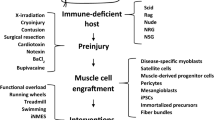Summary
Human muscle (HM) was used in an organ culture system to study the growth of human tumor cells and to test an antitumor drug. The HM system mimicked the in vivo situation regarding the behavior of neoplastic versus normal cells in that tumor cells proliferated extensively and invaded, while normal cells showed only a limited proliferative potential and a limited invasion was observed with fibroblasts but not with epithelial cells. In addition, when human plasma (HP) was used in place of fetal bovine serum (FBS) and cell culture medium as a source of nutrients, the tumor cells displayed a more aggressive histopathologic pattern. The HM system, as illustrated by the 5-FU results, allows the direct visualization of the effect to an antitumor agent not only on tumor cell growth but also on a range of histopathologically evaluable characteristics of the interaction of tumor cells with the host tissue. The HM system provides for the first time an in vitro experimental model using easily accessible adult human tissue to study cancer and its treatment.
Similar content being viewed by others
References
Ikic D, Beck M, Turner V: The testing of cell invasiveness in embryonic tissue and in cell culture. In: (ed) International Association of Biological Standardization. Dev Biol Stand, Karger, Basel, 1977, pp 235–240
Noguchi PD, Johnson JB, O'Donnell R, Petricciani JC: Chick embryonic skin as a rapid organ culture assay for cellular neoplasia. Science 199:980–983, 1978
O'Donnell RW, Noguchi PD, Petricciani JC: Tumorigenicity of chromosomally abnormal cultured cells in two xenogenic organ culture assays. Oncology 38:161–164, 1981
Petricciani JC, Martin DP: Use of nonhuman primates for assaying tumorigenicity of viral vaccine cell substrates. Transplant Proc 6:189–192, 1974
Noguchi PD, Johnson JB, Petricciani JC: Comparison of the nude mouse and immunosuppressed newborn hamster as a quantitativve tumorigenicity test for human cell lines. IRCS Med Sci 7:302, 1979
Noguchi PD, Attallah AM, Petricciani JC: In vivo tumorigenicity models for human cells: past, present and future. IRCS Med Sci 8:126–128, 1980
Levenbook I, Smith PL, Petricciani JC: A comparison of three routes of inoculation for testing tumorigenicity of cell lines in nude mice. J Biol Stand 9:75–80, 1981
Noguchi PD, Wallace R, Johnson J, Early EM, O'Brien S, Ferrone S, Pellegrino MA, Milstein J, Needy C, Browne W, Petricciani JC: Characterization of WiDr: a human colon carcinoma cell line. In Vitro 15:401–408, 1979
Nelson-Rees WA, Daniels DW, Flandermeyer RR: Cross-contamination of cells in culture. Science 212:446–452, 1981
Rasheed S, Nelson-Rees WA, Joth EM, Arnstein P, Gardner MB: Characterization of a newly derived human sarcoma cell line (MT-1080). Cancer 33:1027–1033, 1974
Hayflick L: The limited in vitro lifetime of human diploid cell strains. Exp Cell Res 37:614–636, 1965
Jacobs JP, Jones CM, Barile JP: Characteristics of a human diploid cell designated MRC-5. Nature 227:168–170, 1970
Hopps HE, Berheim BC, Nisalak A, Tjlo JH, Smadel JE: Biological characteristics of a continuous kidney cell line derived from the African Green monkey. J Immunol 91:416–430, 1963
Petricciani JC, Wallace RE, McCoy DW: A comparison of three in vivo assays for cell tumorigenicity. Cancer Res 34:105–108, 1974
Babai J: Etude ultrastructurale sur la pathogenie l'invasion du muscle strie par des tumeurs transplantables. J Ultrastr Res 51:287–303, 1976
Author information
Authors and Affiliations
Additional information
Guest Worker
Rights and permissions
About this article
Cite this article
Petricciani, J.C., Levenbook, I. & Locke, R. Human muscle: a model for the study of human neoplasia. Invest New Drugs 1, 297–302 (1983). https://doi.org/10.1007/BF00177412
Issue Date:
DOI: https://doi.org/10.1007/BF00177412




